Experience the golden age of ukiyo-e in the historical drama “Berabou” with a connoisseur’s feeling on this ukiyo-e tour from Asakusa to Shin-Yoshiwara
Ukiyo-e Cafe plans and operates the “Ukiyo-e Then and Now Tour.”
There are three routes from the city center to Shin-Yoshiwara, which have remained unchanged since the Edo period. The first is a route from Asakusa along the Umamichi road, walking along Nihonzutsumi and going to Yamayabori. The second is a route going up the Okawa (Sumida River), getting off the boat at Imadobashi Bridge, and walking along Nihonzutsumi. The third is a route from Minowa (Minowa) through Nihonzutsumi.
Shin Yoshiwara, which is getting a lot of attention in the historical drama “Berabou”, has always been in a location with poor accessibility. Located behind Sensoji Temple, Shin Yoshiwara is in an area known as “Kannonura” or “Oku Asakusa”. With the establishment of Shin Yoshiwara, the Sensoji area became even more lively, and Asakusa to Shin Yoshiwara became a fashion center in the Edo period. The highly educated and stylish men known as “tsunin” who gathered in Shin Yoshiwara contributed greatly to the maturation of culture. Many stories were spun between the beautiful women of the keisei (red light district) and the tsunin. Around the highly influential Tsutaya Juzaburo, artists such as Hiraga Gennai, Kitao Shigemasa, Katsukawa Shunsho, Utamaro, Sharaku, Hokusai, as well as Koikawa Harumachi, Hoseido Kisanji, and Santo Kyoden gathered together, creating a chemical reaction that ushered in the “Golden Age of Ukiyo-e”. The “Ukiyo-e Then and Now Tour” is a two-hour walking tour visiting famous historical sites along the route from Asakusa to Shin Yoshiwara, where connoisseurs of the Edo period walked, while comparing the scenery with ukiyo-e and old books depicting the scenery of the time.
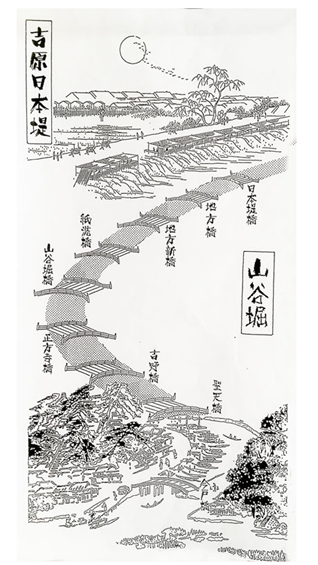
Introduction: What is Shin Yoshiwara?
The only Edo brothel officially recognized by the shogunate, Yoshiwara Red Light District, began when brothels scattered throughout Edo were gathered in a place to the east of Fukiyacho, Nihonbashi (around present-day Ningyocho, Nihonbashi). The area was overgrown with reeds, hence the name “Ashihara” and then “Yoshiwara” as auspicious names. After a great fire in 1657, it was moved to Senzokumura, Asakusa (present-day Senzoku, Taito Ward) by order of the shogunate. Since then, Yoshiwara when it was located around Fukiyacho, Nihonbashi, has been called “Motoyoshiwara,” and Yoshiwara after the move has been called “Shinyoshiwara.” It was also called Kitaguni because it moved to the north.
Tour route (Asakusa – Shin-Yoshiwara) information
Saruwaka Town
Ukiyo-e: Night of the Monkeys (Utagawa Hiroshige) Evening Glory of the Monkeys and the Moon (Utagawa Kunisada)
Saruwakacho (now part of Asakusa 6-chome) was a theater town in the late Edo period. Kabuki was popular as entertainment for the masses during the Edo period, but during the Tenpo Reforms, the abolition of theaters was proposed for a time because it was considered to be disruptive to public morals. However, due to a proposal by Toyama Saemonnojo Kagemoto (Toyama no Kinsan) that “taking away entertainment from the common people would not contribute to the stability of the people’s minds,” the shogunate-approved theaters were forced to move to this area on the outskirts of Edo. Then, theaters, teahouses, and homes for actors and people involved in theater were built, and the area flourished until the early Meiji period, centering on the shogunate-approved Nakamura-za, Ichimura-za, and Morita-za (the three Saruwaka theaters). The town was named after Saruwaka (Nakamura) Kanzaburo, who is said to be the founder of Edo Kabuki. At the time, this area was a major entertainment district, with visitors to Sensoji Temple, people going to Yoshiwara, and people coming to see plays, but the theaters were gradually relocated. Today, there is no trace of what it was like back then, but the street depicted by Hiroshige remains, with popular stores such as the long-established Terasawa Cake & Bread Shop. There is also a monument and an explanatory plaque at the site of the theater, so be sure to check it out.
Matsuchiyamashoden(Machichiyama)
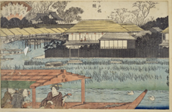
Ukiyo-e: Edo Komin Kaiten, Imadobashi no Zu, Hiroshige
A picture of people departing from Yanagibashi or Imadobashi on a houseboat and enjoying cherry blossom viewing with singing and lunch while gazing at Mt. Machi. Further upstream, north of Hashiba no Ferry, the area on the west bank of the Sumida River is home to Masaki Inari Shrine and Ishihama Shinmei Shrine, and is known as a scenic spot on the Sumida River.
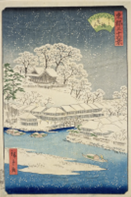
Ukiyo-e: Imado Bridge and Mt. Machinyu (Thirty-six Views of the Eastern Capital)
Hiroshige left behind many works depicting the surrounding areas of Mt. Machinyu and Masaki. It was a scenic spot that could be enjoyed throughout the four seasons.
Matsuchiyama Shoden (Machiyama), located on the west bank of the Sumida River, is a sacred mountain that suddenly appeared from the ground in 595 (the third year of the reign of Empress Suiko), and is said to have been protected by a golden dragon that descended from the sky and circled the mountain. It is a hill about 10 meters above sea level. During the Edo period, it was popular as a scenic spot overlooking the Sumida River, and many poets and artists have created works based on Matsuchiyama. Matsuchiyama Shoden, which has a temple here, is officially called Honryu-in and is one of the branch temples of Sensoji Temple. The radishes and drawstring bags marked in various places in the temple grounds succinctly represent the great benefits of Shoden, and the shrine is often talked about as a place where radishes are offered. It is said that radishes have the ability to neutralize toxins in the body and aid digestion, and they are an indispensable offering for memorial services. Many radishes are offered in the main hall, so be sure to check them out. The grounds also feature the Tsukiji wall that was depicted in Hiroshige’s ukiyo-e prints, giving a sense of Edo-period vibes. In addition, there is a cable car (slope car: Sakura Rail), one of the shortest in Japan, that can be used to go up to the grounds from the parking lot behind the temple grounds, so be sure to try it out.
Imado Shrine: Imado ware
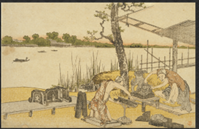
Ukiyo-e: Imado ware, Hokusai
Smoke was rising from several hearths along the Okawa River. The area around Imado Bridge was convenient for transporting heavy pottery such as tiles by ship and land.
When the Sanya moat was still a moat, there was a bridge called Imadobashi at the confluence of the Sumida River and the Sanya moat, and the ukiyo-e prints of Katsushika Hokusai and Utagawa Hiroshige depict the scene of Imado ware being manufactured. The moat has now been filled in, and the site of Imadobashi has become a park. Imado was once a thriving area for pottery called Imado ware, and Imado ware craftsmen manufactured and sold pottery such as roof tiles, everyday items, clay dolls, and crafts to meet the needs of Edo-Tokyo residents. Imado Shrine, which is popular as a power spot for love fulfillment, is also known as the final resting place of Okita Souji, a genius swordsman of the Shinsengumi who is said to have been handsome.
Sumida River (Sumida Park) – Imado Bridge – Yamayabori Park
The Sumida River was the main artery of transportation for the people of Edo, and also the route for boat transport to Shin Yoshiwara. At that time, it was called the Okawa River. The Okawa River merged with the Yamayabori River at Imado Bridge.
During the Edo period, the Yamayabori River was a tributary (for agricultural use) of the Otonashi River that flows through Minowa Bridge. The source of the Otonashi River is spring water from Shakujii Sanboji Pond, and the irrigation canal that collected the surplus water from the Kodaira Tanashi Irrigation Canal and flowed through Tabata Nippori was called the Otonashi River. The waterway that flowed beside the Nihon Tsutsumi and emptied into the Sumida River was called the “Yamayabori” (Sanya-dori). Using the Yamayabori River to go to Yoshiwara was called “Yamaya-dori” and was considered more elegant and refined than the land route. Many great writers went to Yamaya, and it is depicted as the setting for many novels. Famous writers include Ota Nanpo, Nagai Kafu, Kawabata Yasunari, and Ikenami Shotaro.
This Sanyano moat stretched from the foot of Matsuchiyama to Yoshiwara Daimon Gate, and had nine bridges (Ima-bashi, Shoten-bashi, Yoshino-bashi, Shohoji-bashi, Sanyanobori-bashi, Kamiarai-bashi, Chiho-shinbashi, Chiho-bashi, and Nihon-tsutsumi-bashi). The boats used were called “Iga-bune” (boats), which had a long, narrow, pointed bow and were about 30 shaku long and 4 shaku 6 sun wide, making them fast boats. Reclaiming of Sanyanobori began in the early Showa period, and by 1975 it was all covered, and it has been reborn as the long, narrow “Yamanobori Park.” The park is now also popular as a cherry blossom viewing spot, and you can see Tokyo Skytree from the rows of cherry blossom trees, making it a great photo spot. There is also a sculpture of an Iga-bune enshrined in the park, so don’t miss it!
Shohoji Temple
This is the family temple of Tsutaya Juzaburo, the protagonist of the NHK historical drama “Berabou – Tsutaju Eika no Yume Banashi”. It is a Nichiren sect temple that enshrines Bishamonten, one of the “Three Great Bishamonten Temples of Edo” along with Zenkokuji Temple in Kagurazaka and Shodenji Temple in Shiba, and has been a building-type temple since 1994. Tsutaya Juzaburo died of illness at the age of 48 in 1797 and was buried at Shohoji Temple. It was later lost to earthquakes and war damage, but now there is a tombstone and memorial monument in the outer cemetery to the left of the main hall, which have been reproduced based on old documents. His real name, Kitagawa Karamaru, is engraved on the tombstone, and inscriptions of Tsutaya Juzaburo himself and his mother are also engraved.
Japan Tsutsumi
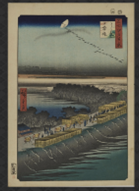
Ukiyo-e: One Hundred Famous Views of Edo, Yoshihara Nihonzutsumi by Hiroshige
Nihonzutsumi was a levee built by the shogunate to prevent flooding caused by the overflow of the Sumida River, and connected what is now Asakusa 7-chome to Minowa. In those days, to go to Yoshiwara by water, visitors would go up the Sumida River, enter a narrow moat called Yamayabori, get off their boats halfway, and go to Nihonzutsumi on foot or in a palanquin. Some people would boast about their frequent visits to Yoshiwara, saying things like “I’m familiar with the eight dotes.” At the time, it was a charming place that was considered one of Edo’s famous places, and it was said to be picturesque in the summer evenings when many boar boats came and went. It is also famous for “Yoshihara Nihonzutsumi,” an ukiyo-e series by Utagawa Hiroshige that depicts Edo’s famous places. After the Great Kanto Earthquake, the embankment was demolished, and the site became a road called “Dote-dori.” In the past, horse meat was thought to have the effect of preventing syphilis infection, and sakura nabe restaurants lined the embankment in front of the red-light district. Currently, “Nakae to Atsumiya” is still in business, and along the embankment street there is “Yoshiwara Embankment Specialty Horse Meat Chibaya”, retaining vestiges of the area.
Willow tree
This willow tree grew near the entrance to the Yoshiwara red-light district, and is said to have been named “Mikaeriyanagi” (“looking back”) because customers would look back reluctantly as they left. It was once located on the bank beside the Sanya moat, but it has been replanted over the years due to earthquakes and war damage, and is now located in front of a gas station at Yoshiwara Daimon intersection in Senzoku, Taito Ward. The Mikaeriyanagi appears at the beginning of Higuchi Ichiyo’s novel “Takekurabe,” and has also been the subject of many senryu poems. Also famous is the tempura restaurant “Dote no Iseya,” which opened in 1889 and is located diagonally opposite the Mikaeriyanagi, and the building is a registered tangible cultural property of the country.
Imonzaka
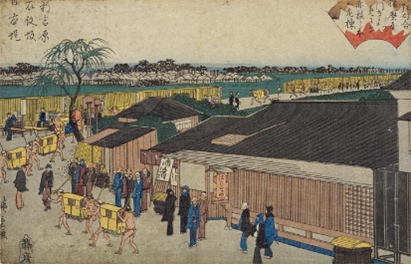
Ukiyo-e: Edo's Famous Places of Interest, Shin-Yoshiwara, Imonzaka, Nihon-tsutsumi, Hiroshige
Imonzaka slope runs down from Nihonzutsumi to Daimon, the only entrance and exit to Yoshiwara red light district. The name of the slope is said to come from the fact that many people would straighten their kimono (grooming) as they descended from the bank into the red light district. After the Great Kanto Earthquake, the bank was demolished and the slope was also demolished, and now the land is flat.
Gojikendo
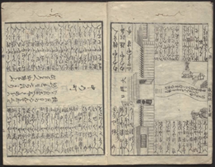
Ukiyo-e: Yoshiwara Hosomi, Japanese white pine, Tsutaya Juzaburo, published by Koshodo.
Going down Imonzaka, past Mikaeriyanagi and along Gojikken-dori, you will arrive at Shin Yoshiwara Daimon. On the left side of the street you can see the shops of "Tsutaya Jirobei Teahouse" and "Hosomi Kaiji Bookstore Tsutaya Juzaburo".
Gojikken-michi is the only road leading to the entrance of Yoshiwara. If you go down Imonzaka from Nihonzutsumi using the Mikaeriyanagi as a landmark, you will come across Gojikken-michi, a road that curves in an S shape from there to Daimon. It was named Gojikken-michi because it was 50 ken (about 90m) long, and the street was lined with Yoshitoku Inari Shrine, teahouses, and Amigasasachaya, as well as Tsutaya Juzaburo’s rental book and local book store Koshodo. It is said that the unnatural S-shaped curve was made to prevent the shogun and daimyo from seeing the red-light district from Nihonzutsumi when they passed by, and this curve remains to this day.
The birthplace of Tsutaya Koshodo (Ukiyo-e Cafe)
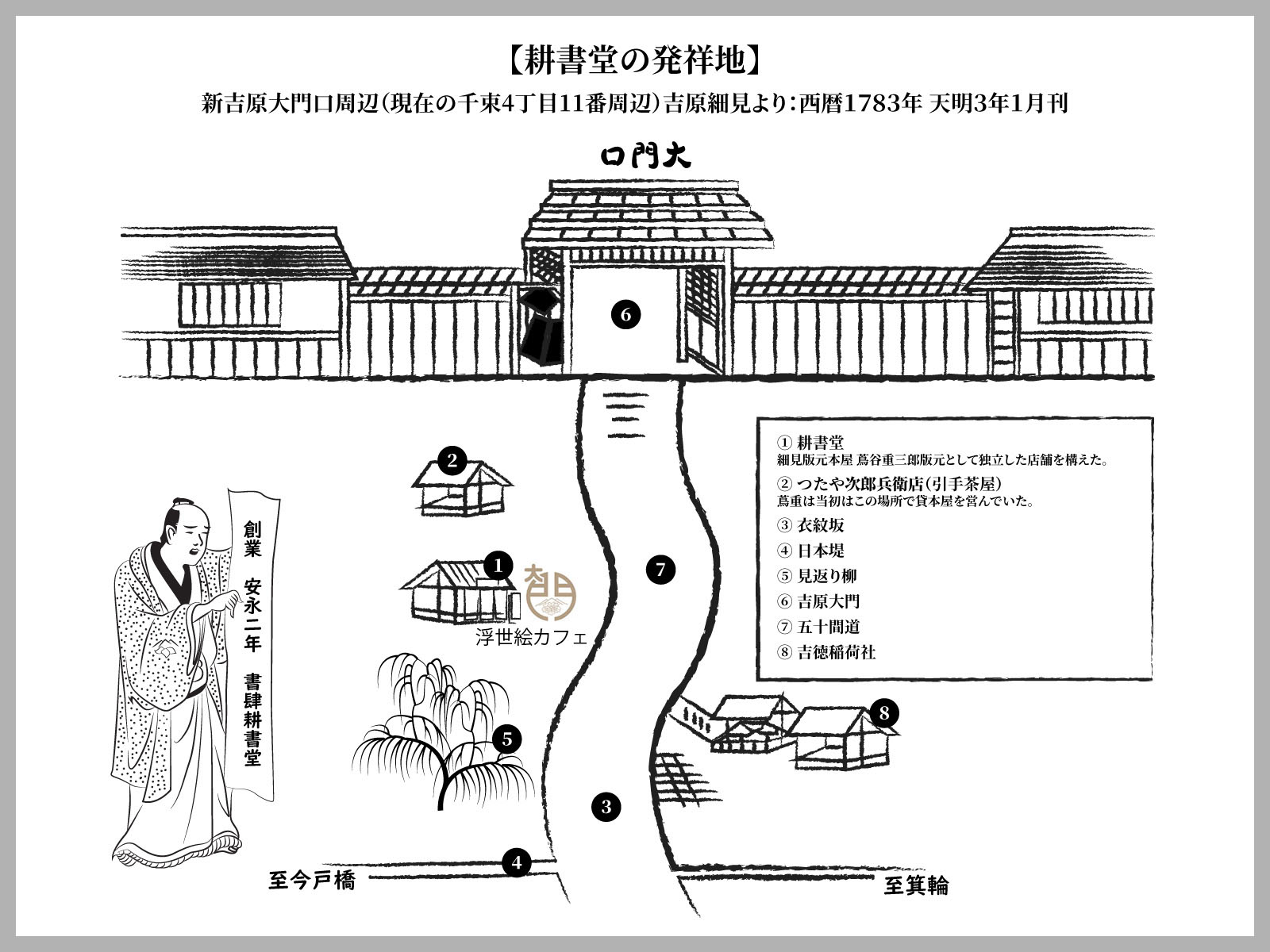
Tsutaya rented space from his brother-in-law’s shop, Hikitechaya Tsutaya, and ran a book rental business. Taking advantage of the Urokogataya counterfeiting incident, Tsutaya opened an independent shop, Koshodo, on Gojikkan Street around 1776 (5th year of the An’ei era), as a Hosomi and Jihon wholesaler. The colophon of Hosomi at that time lists the location as “Shin Yoshiwara Daimonguchi”. At the Ukiyo-e Cafe, original ukiyo-e and Japanese books created by Tsutaya Juzaburo during the Edo period are on display and for sale. Please take your time to enjoy the authentic woodblock prints along with some hand-dripped coffee.
Gojikendo
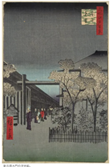
Ukiyo-e: Shin Yoshiwara Daimon by Hiroshige
Gojikken-michi is the only road leading to the entrance of Yoshiwara. If you go down Imonzaka from Nihonzutsumi using the Mikaeriyanagi as a landmark, you will come across Gojikken-michi, a road that curves in an S shape from there to Daimon. It was named Gojikken-michi because it was 50 ken (about 90m) long, and the street was lined with Yoshitoku Inari Shrine, teahouses, and Amigasasachaya, as well as Tsutaya Juzaburo’s rental book and local book store Koshodo. It is said that the unnatural S-shaped curve was made to prevent the shogun and daimyo from seeing the red-light district from Nihonzutsumi when they passed by, and this curve remains to this day.
Blackened Teeth
Shin Yoshiwara was about 270m x 360m in size, and was surrounded by high walls and a moat called Ohaguro-dōbu to prevent the escape of prostitutes. Women needed a wooden piece called a “stamp” to pass through the main gate and go outside, and nine “drawbridges” were usually raised for emergency use, blocking the way of prostitutes who tried to escape from the pleasure quarter. At the same time, they also served to catch customers who ate and drank without paying. It is said that the name comes from the fact that the prostitutes would throw away the ohaguro that they had used, and the width of the moat was 9m when the area first opened, but it became 3.6m from the end of the Edo period to the beginning of the Meiji period, and shrunk to 90cm at the end of the Meiji period. Nowadays, only a small amount of the stone wall remains.
Shirobe Kaisho
Upon entering the main gate, on the left was the “Menbansho” (guard station) under the magistrate’s office, and on the right was the Yoshiwara Kaisho (Shirobei Kaisho), a private security organisation. It is said that the place got its name from the fact that Miuraya Shirouzaemon, the owner of a large store, had an employee named Shirouzaemon on full-time security duty, and the place was where the household register was managed. The guards here kept watch to ensure that no suspicious characters were overlooked, and in particular, they managed the passports required for women to enter and leave in order to prevent disguised prostitutes from escaping. Even today, there is a police box on the right.
Pull teahouse “Kanemura”
Kanamura is the last Hikite-chaya in Yoshiwara. A Hikite-chaya is a place where you can have a drink, a light meal, and enjoy geisha and taikomochi before enjoying yourself with a high-class courtesan. Kanamura continued to operate as a restaurant for a while after the Yoshiwara red-light district was abolished, but was scheduled to close in 2009. However, it has been taken over by Sakura Nabe Nakae Annex Kanamura, with the feeling that “it would be a shame to let the light of Yoshiwara’s culture and history go out.”
Daimonjiro
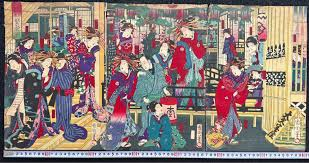
Ukiyo-e: Ukiyo-e Daimonjiro Kunichika
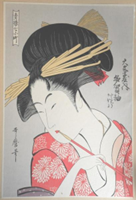
Ukiyo-e: Tagasode (Who's Sleeves) by Utamaro
Daimonjiro, along with Kakuebiro and Inamotoro, was one of the three great brothels of Shin Yoshiwara. In the NHK historical drama “Berabou – Tsutajueika no Yumebanashi”, the owner Daimonjiya Ichibei, played by Ito Atsushi, is the second generation owner. His nickname is “Pumpkin”. He also made a name for himself as a kyoka poet, and organized a group of kyoka poets called “Yoshiwara Ren”. Tsutaya Juzaburo also belonged to the Yoshiwara Ren. The first generation started out as a riverside establishment, but eventually moved to Edo-machi as a large establishment. The courtesan’s name “Daresode” was particularly famous as a great name, and the name was passed down until the Meiji era. The site of Daimonjiro is now “Yoshiwara Park”.
Shinkoshodo
This facility is a replica of the Yoshiwara Kaikan Hall, which was opened by Tsutaya Juzaburo in front of the main gate of Yoshiwara for one year only. Panels explaining the origins of Shin Yoshiwara and high geta sandals worn by courtesans are on display. Many souvenirs exclusive to Taito Ward are on sale.
Yoshiwara Shrine (Daimon)
There are five Inari shrines in Shin Yoshiwara as guardian deities, including the Yoshitoku Inari Shrine in front of the Yoshiwara Daimon Gate, and the Enomoto Inari Shrine, Akashi Inari Shrine, Kaiun Inari Shrine, and Kurosuke Inari Shrine at the four corners of the red-light district. These five Inari shrines were enshrined together in 1881 to form Yoshiwara Shrine. When it was first built, it was enshrined at the old site of the Yoshitoku Inari Shrine, but it was burned down in the Great Kanto Earthquake. After the earthquake, it was enshrined in a temporary shrine building near Suidojiri, but in 1934, a new shrine building was built at the current location, and Yoshiwara Benzaiten, which was adjacent to the red-light district, was also enshrined at that time, making a total of six shrines (gods) enshrined. It was later burned down in the Great Tokyo Air Raid in 1945, but the current shrine building was built in 1968 and remains to this day.
Yoshiwara Benzaiten
Yoshiwara Benzaiten is enshrined in Yoshiwara Shrine and is not an independent shrine, but many remains remain, including a memorial stone. In the past, there was a pond about 50m in diameter called Hanazono Pond (Benten Pond) here, and when the Great Kanto Earthquake occurred, courtesans rushed to the pond, fleeing from the raging fire. It is said that more than 500 courtesans, unable to move, were burned or drowned, piled on top of each other as they jumped into the pond one after another to escape the flames and smoke. For this reason, it is well known that the writer and Buddhist monk Ieda Shoko holds a memorial service for the courtesans every month. Many newspaper clippings are posted on the wall on the left side of the temple grounds, and most of them are articles about Ieda Shoko.
